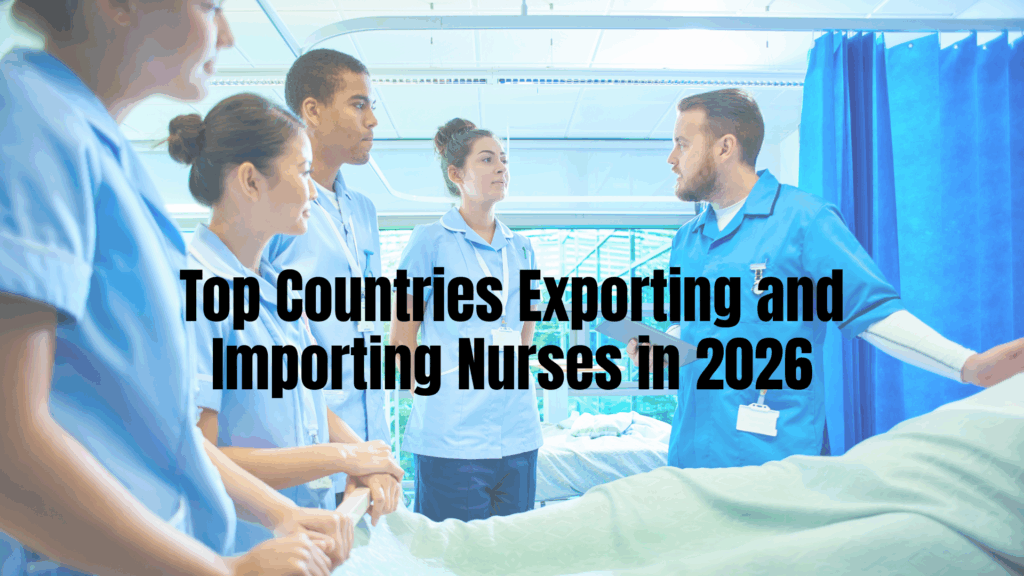Introduction
The top countries exporting and importing nurses in 2026 is useful information in an increasingly interconnected world. Especially, when the movement of healthcare professionals, particularly nurses, has become a critical component of global health systems. The “nurse pipeline” refers to the flow of qualified nurses and other healthcare workers from countries with surpluses or training programs geared toward export to nations facing acute shortages due to aging populations, rising healthcare demands, and workforce attrition. This migration is not merely a labor market phenomenon; it’s a lifeline for many high-income countries struggling to maintain their healthcare infrastructures, while simultaneously posing challenges for lower-income nations that invest in training but lose talent abroad.
As of 2025, the global nursing workforce stands at approximately 29 million, yet the World Health Organization (WHO) estimates a shortfall of 5.9 million nurses to achieve universal health coverage by 2030. This gap is exacerbated by demographic shifts: in many developed countries, baby boomers are retiring, increasing the need for elder care, while pandemics like COVID-19 have highlighted vulnerabilities in healthcare staffing. Nurse migration has surged in recent years, with data showing that nearly 12% of nurses worldwide work in a country other than their birth nation. Recent reports indicate that one in seven nurses globally is foreign-born, underscoring the scale of this international exchange.
The dynamics of this pipeline are driven by push and pull factors. Push factors in exporting countries include limited job opportunities, low wages, and political instability, while pull factors in importing nations encompass higher salaries, better working conditions, and streamlined immigration pathways for skilled workers. For instance, countries like the United States and the United Kingdom have implemented visa programs specifically targeting healthcare professionals to address domestic shortages. However, this flow raises ethical questions about “brain drain,” where source countries suffer from depleted healthcare systems, potentially worsening health outcomes for their populations.
This article explores the top countries exporting and importing nurses in 2026, and the key players in the nurse pipeline, examining top exporting and importing countries based on recent data from organizations like the OECD, WHO, and the Commission on Graduates of Foreign Nursing Schools (CGFNS). We’ll delve into trends, statistics, and impacts, providing a comprehensive view of this vital global issue.
The Global Nursing Shortage: Context and Trends
The global nursing shortage is a multifaceted crisis rooted in supply-demand imbalances. According to the International Council of Nurses (ICN), an aging workforce is a primary driver: 17% of nurses worldwide are expected to retire within the next decade, necessitating 4.7 million new recruits just to maintain current levels. Compounding this, the COVID-19 pandemic accelerated burnout and attrition, with many nurses leaving the profession due to high stress and inadequate support.
Migration trends reveal a predominantly South-to-North pattern, where nurses from low- and middle-income countries (LMICs) move to high-income countries (HICs). The CGFNS 2024 Nurse Migration Report, which analyzes data from over 100 countries, notes that nearly 25,000 nurses applied for U.S. visas in 2024 alone, a figure that held steady but is deemed unsustainable long-term. The 2023 edition of the report highlights a “career mobilization” of global nurses, with applications surging from Asia and Africa.
Intra-regional migration is also rising. In Africa, nurses move between countries like South Africa and neighboring states, while in Asia, flows occur within the region before extending northward. OECD data shows that the proportion of foreign-trained nurses in member countries has doubled in some cases over the past decade. For example, in 2021, nearly 9% of nurses in OECD nations were foreign-educated, up from 5% a decade prior.
Economic incentives are stark: Nurses in HICs can earn 5-10 times more than in their home countries. In the Philippines, a starting nurse salary might be $500 monthly, compared to $4,000 in the U.S. This disparity fuels the pipeline but creates vulnerabilities. The WHO has expanded its Health Workforce Support and Safeguards List to 55 countries in 2023, urging HICs to avoid aggressive recruitment from these fragile systems.
Recent OECD findings indicate 8X growth in foreign-born nurses in countries like Finland and Germany. As populations age, with the global over-65 demographic projected to double by 2050, the demand will intensify, making ethical migration management crucial.
Major Exporting Countries
Exporting countries, often LMICs, train nurses in excess of domestic needs, sometimes explicitly for international markets. The Philippines stands as the undisputed leader, exporting tens of thousands annually. Known as the world’s top nurse exporter, the country faces its own shortages as healthcare systems struggle to retain talent. In 2024, Filipino nurses comprised a significant portion of U.S. visa applicants, drawn by programs like the EB-3 visa. The government’s labor export policy, dating back to the 1970s, has institutionalized this flow, but it leads to domestic understaffing, with rural areas particularly affected.
India follows closely, with its vast nursing education system producing over 100,000 graduates yearly. Indian nurses migrate to the Gulf states, Europe, and North America, driven by better opportunities. States like Kerala and Punjab are hotspots for training, with many institutions aligned to international standards. However, this exodus contributes to India’s own shortage of 2 million nurses.
African nations are emerging as key exporters. Nigeria, Ghana, and Kenya supply nurses to the UK and U.S., where English proficiency eases integration. In Zambia, registered nurses have a 7.7 times higher migration probability than enrolled nurses. The brain drain here is acute: Sub-Saharan Africa, with 25% of the global disease burden, has only 3% of the world’s health workers.
Other notable exporters include Jamaica and Haiti in the Caribbean, where remittances from migrant nurses bolster economies but strain local services. In Eastern Europe, Romania and Poland export to Western Europe, filling gaps in Germany and the UK.
To illustrate the scale, here’s a table of top exporting countries based on recent migration data:
| Country | Estimated Annual Exports | Primary Destinations | Key Notes |
|---|---|---|---|
| Philippines | 20,000+ | USA, UK, Saudi Arabia | Top global exporter; government-supported programs. |
| India | 15,000+ | UAE, USA, UK | Focus on Gulf and Anglophone countries. |
| Nigeria | 5,000+ | UK, USA, Canada | Rising due to English skills and demand. |
| Kenya | 3,000+ | UK, Australia | Part of African intra-regional flows. |
| Jamaica | 2,000+ | USA, Canada | Remittances key to economy. |
Major Importing Countries:
Importing countries are typically HICs with aging populations and robust healthcare systems but insufficient domestic training. The United States leads, importing nurses primarily from the Philippines and India. In 2024, U.S. hospitals accelerated hiring from abroad to combat shortages, with foreign nurses making up about 15% of the workforce. Programs like the H-1B and EB-3 visas facilitate this, though backlogs persist.
Canada, with the highest global demand for nurses, offers high salaries and strong social supports. Provinces like Ontario and British Columbia actively recruit, with foreign-trained nurses comprising 7.7% in 2015, a figure that has grown. Canada’s Express Entry system prioritizes healthcare workers.
The United Kingdom, post-Brexit, has ramped up international recruitment, with 15.2% of nurses foreign-trained as of 2016. The NHS relies heavily on imports from the Philippines, India, and Nigeria, though ethical guidelines aim to curb poaching from red-listed countries.
In Europe, Germany has seen explosive growth, with foreign-born nurses increasing significantly. Initiatives like the Triple Win program train and recruit from the Philippines and Vietnam. Switzerland, with 18.7% foreign-trained nurses, offers high pay but requires language proficiency.
Australia and New Zealand also import heavily, with 23.3% and 26.7% foreign-trained nurses, respectively. Australia’s Skilled Migration Program targets nurses, while New Zealand’s subclass 189 visa eases entry for BSN holders.
Emerging importers include Saudi Arabia and the UAE, attracting nurses with tax-free salaries.
Here’s a table of top importing countries:
| Country | % Foreign-Trained Nurses | Primary Sources | Key Policies |
|---|---|---|---|
| USA | ~15% | Philippines, India | EB-3 visas. |
| Canada | ~8-10% | Philippines, India | Express Entry. |
| UK | 15.2% | India, Philippines, Nigeria | NHS ethical recruitment. |
| Germany | Growing rapidly | Philippines, Vietnam | Triple Win program. |
| Australia | 23.3% | India, UK | Skilled Migration. |
Impact of Nurse Migration
The nurse pipeline benefits importing countries by filling gaps and enhancing diversity, but it drains exporting nations. In the Philippines, domestic shortages lead to overworked staff and poorer care. Remittances at over $35 billion annually from Filipino migrants, provide economic uplift, but at a health cost.
Ethical recruitment is debated: The ICN calls international hiring a “great global rip-off” for LMICs. WHO’s code promotes bilateral agreements, yet enforcement is weak.
Positive impacts include knowledge transfer upon return and global skill elevation. Solutions involve investing in domestic training in HICs and compensation mechanisms for source countries.
Conclusion
The nurse pipeline is a double-edged sword, sustaining global health while perpetuating inequalities. As demand grows, balanced approaches, ethical recruitment, training investments, and international cooperation, are essential. By 2030, without action, shortages could worsen, affecting universal health goals. Policymakers must prioritize sustainability to ensure equitable healthcare worldwide, and fair trade between countries exporting and importing nurses in 2026 and beyond.




